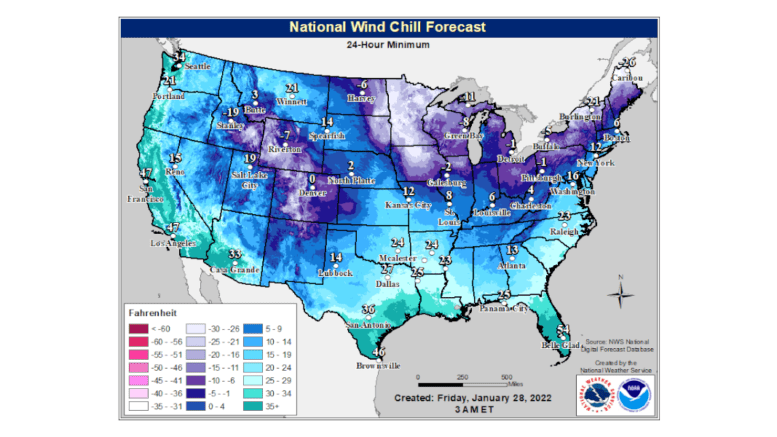In addition to the statement from the National Weather Service warning of bitter cold temperatures with gusty winds overnight Friday, AAA — the Auto Club Group issued its own Arctic Air Advisory for the state.
A press release from Montrae Waiters, the organization’s spokeswoman, stated:
As arctic air is anticipated to blast Georgia and with the weather forecast calling for some of the coldest temperatures of the year thus far, AAA is issuing a Georgia statewide Arctic Air Advisory.
Temperatures are expected to hover in the teens and single digits this weekend, with wind chills 6-12° for a few hours Saturday morning. Extremely cold temperatures can wreak havoc on a vehicle’s functionality.
AAA offered the following tips for getting through the cold weekend intact:
AAA Safety Tips
- If you must be on the road, check the weather before setting out and change plans accordingly.
- Prepare your vehicle by checking the following: Battery strength — faulty batteries cause more car starting problems than any other factor. At 0 degrees, a good battery has 35 percent less starting power. Additionally, batteries that are 3-5 years old will have much less starting power in cold conditions. Tire inflation — under-inflated tires can be dangerous, and may suffer damage. Tire air pressure decreases 1-2 psi for every 10 degree temperature drop. Wiper blades — the blades should completely clear the glass with each swipe. Replace any blade that leaves streaks or misses spots. In areas with snow, consider installing winter wiper blades that wrap the blade frame in a rubber boot to reduce ice and snow buildup. Washer fluid — fill the windshield washer fluid reservoir with a winter cleaning solution that has antifreeze components to prevent it from freezing.
- Pack a well-stocked emergency kit with a cell phone car charger; first-aid kit; extra blankets, hats, gloves and coats; plenty of drinking water and non-perishable snacks for passengers, including pets; flashlight and extra batteries; reflective warning triangles; and an ice scraper or snow brush.
- Always drive at a safe speed that matches the prevailing visibility, traffic and road conditions – even if that means driving below the posted speed limit.
- Compensate for reduced traction by increasing your following distances (normally three to four seconds) to eight to ten seconds.
- Allow sufficient room for maintenance vehicles and plows, stay at least 200 feet back and, if you need to pass, go to the other vehicle’s left.
- Watch for icy surfaces on bridges and intersections, even if the rest of the road seems to be in good condition.
- Avoid braking on ice. If you’re approaching a patch of ice, brake during your approach. Control the skid. Applying pressure to your brakes while on ice will throw your car into a skid.
- If you get stuck in snow or ice, straighten the wheel and accelerate slowly. Add sand or cat litter under the drive wheels to help avoid spinning the tires.
- If your tires lose traction, continue to look and steer in the direction you want to go. If the drive wheels start to spin or slide while going up a hill, ease off the accelerator slightly and then gently resume speed.
- If you find yourself in an emergency situation, please call 911.
For more tips like these, click here.
AAA’s Tips for Stranded Motorists
- Stay in the vehicle. Your car can provide shelter, allowing emergency responders to best locate you, and prevent you from being struck by an approaching vehicle. If you must get out of the car, ensure the surroundings are safe.
- To make the gas last longer, don’t leave the car running. If there is an extended traffic jam turn off the engine and then back on to reheat once it’s gotten too cold again. Make sure the exhaust pipe is snow-free.
- Avoid driving on the shoulders or medians of highways to get around the traffic jam. These need to be kept clear for first responders, tow trucks, and emergency vehicles to get to the cause of the stoppage.
- Cold weather can shorten the range of electric vehicles. EV drivers should plan for more frequent stops for charging and identify the location of charging stations before you hit the road. AAA recommends “pre-heating” the inside of your electric vehicle to a comfortable temperature while still connected to the charger. This will reduce the vehicle’s battery demand to regulate cabin temperature at the onset of driving.
